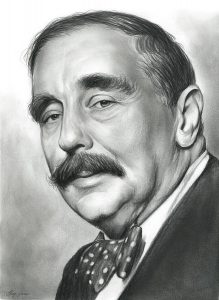Introduction to H.G. Wells

Early Life
Wells grew up under the continual threat of poverty, and since age 14, he was apprenticed to various people. He came from a working class background. His father played professional cricket and ran a hardware store for a time. He continually suffered from poor health and was bedridden because of an accident at the age of 7. During this time, he went through many books, including some by Washington Irving and Charles Dickens. At 18 he won a scholarship to study biology at the Normal School (later the Royal College) of Science, in South Kensington, London. He became a science teacher and underwent a period of ill health and financial worries supplemented by a bad marriage, in 1891, to his cousin, Isabel Mary Wells because of which he ran off with Amy Catherine Robbins who was his former pupil, and became his second wife in 1895.
Early Writings
Later Works
In 1920, H.G. Wells published ‘The Outline of History’, which was perhaps his best selling work during his lifetime. This three-volume work commenced with prehistory and followed the world’s events up through World War I.
He caught up so vividly with the energy of this period, its adventurousness, its feeling of release from the bounds of Victorian thought and the so called mannerisms. His influence was enormous, both on his own generation and on that which immediately followed it. Wells was unyielding and fearless in his efforts for social equality and world peace. In his science fiction, he took the ideas occupied the mind of his age and gave them symbolic expression. His best work has a narrative style, extraordinary ideas and a vitality that is unsurpassed.